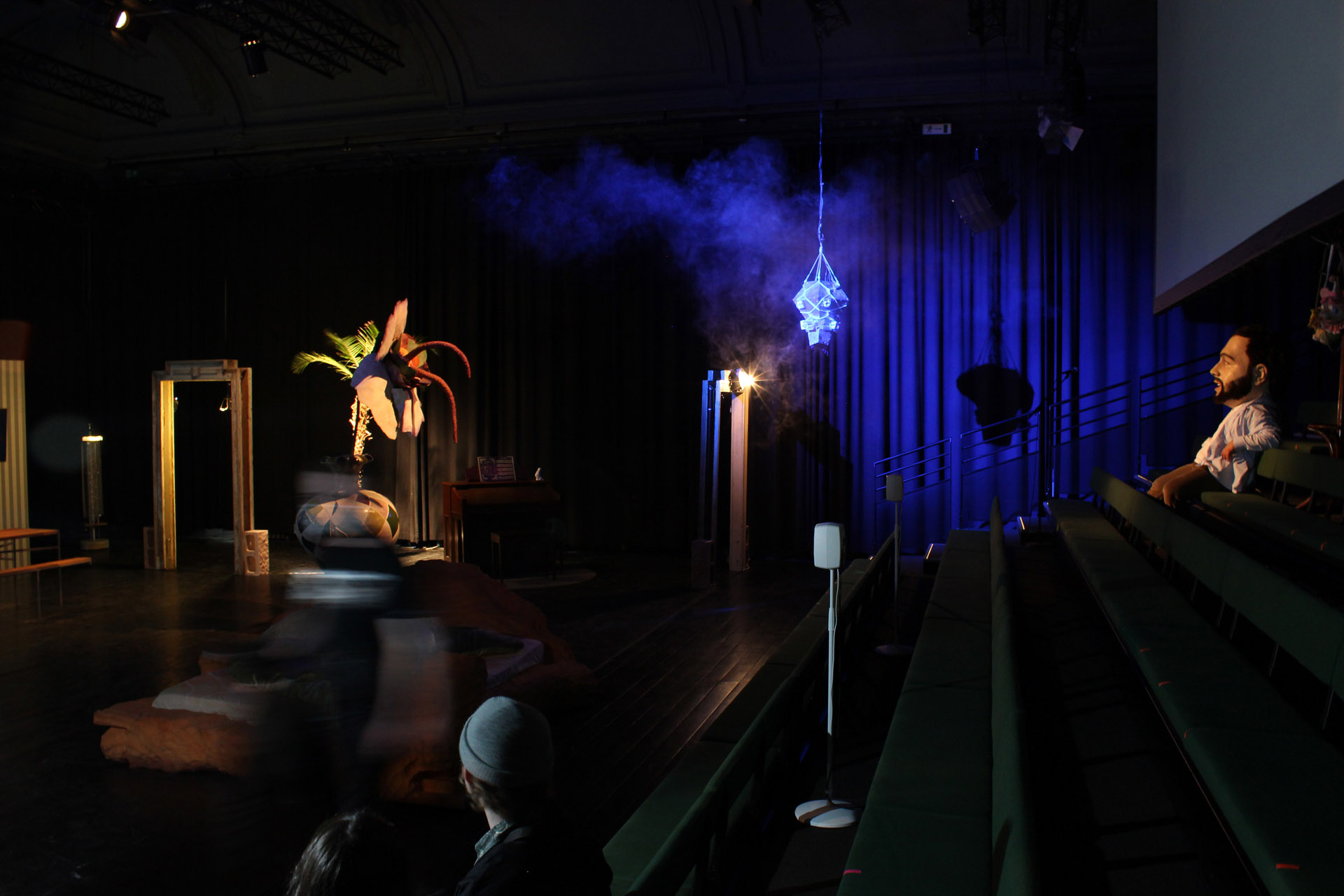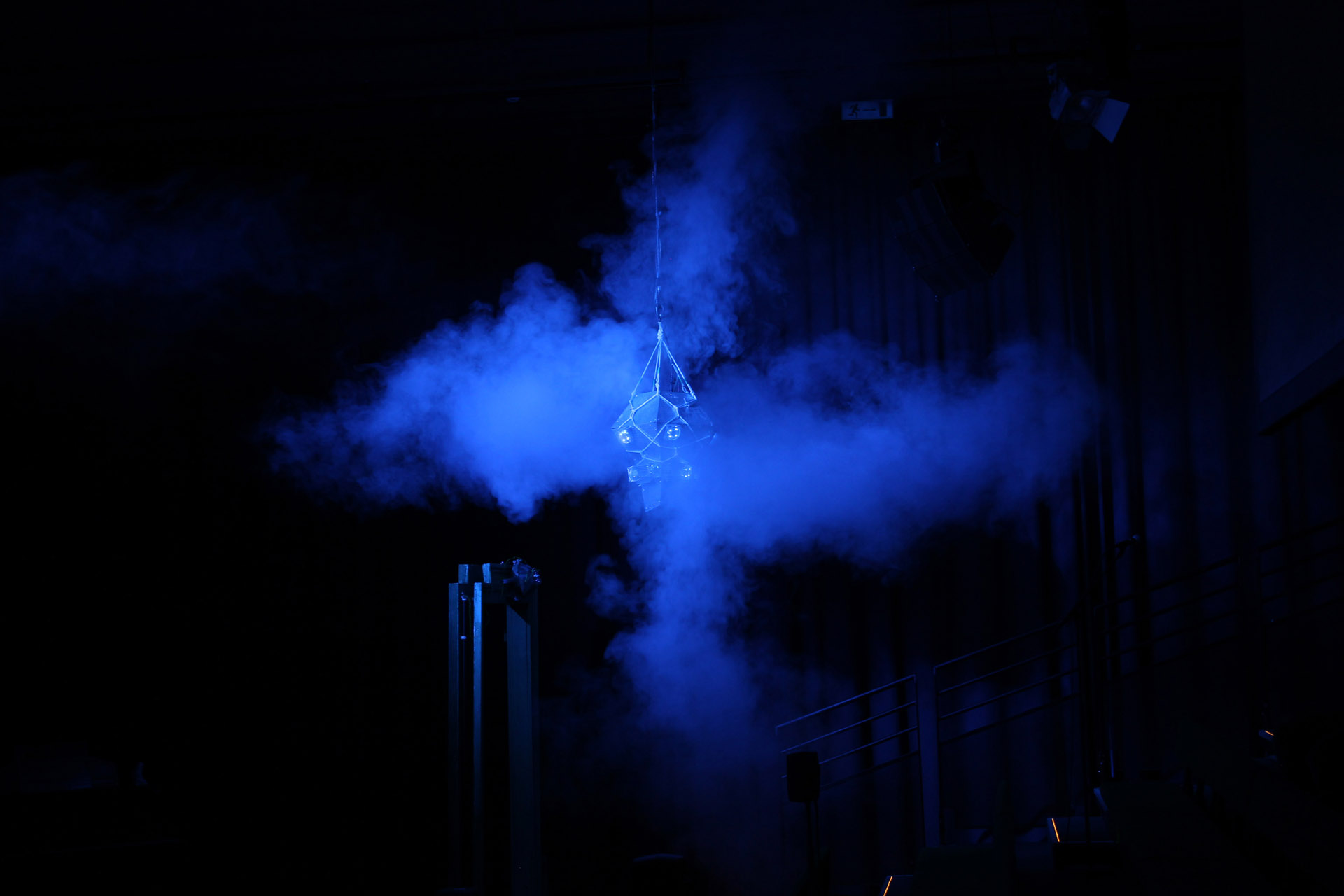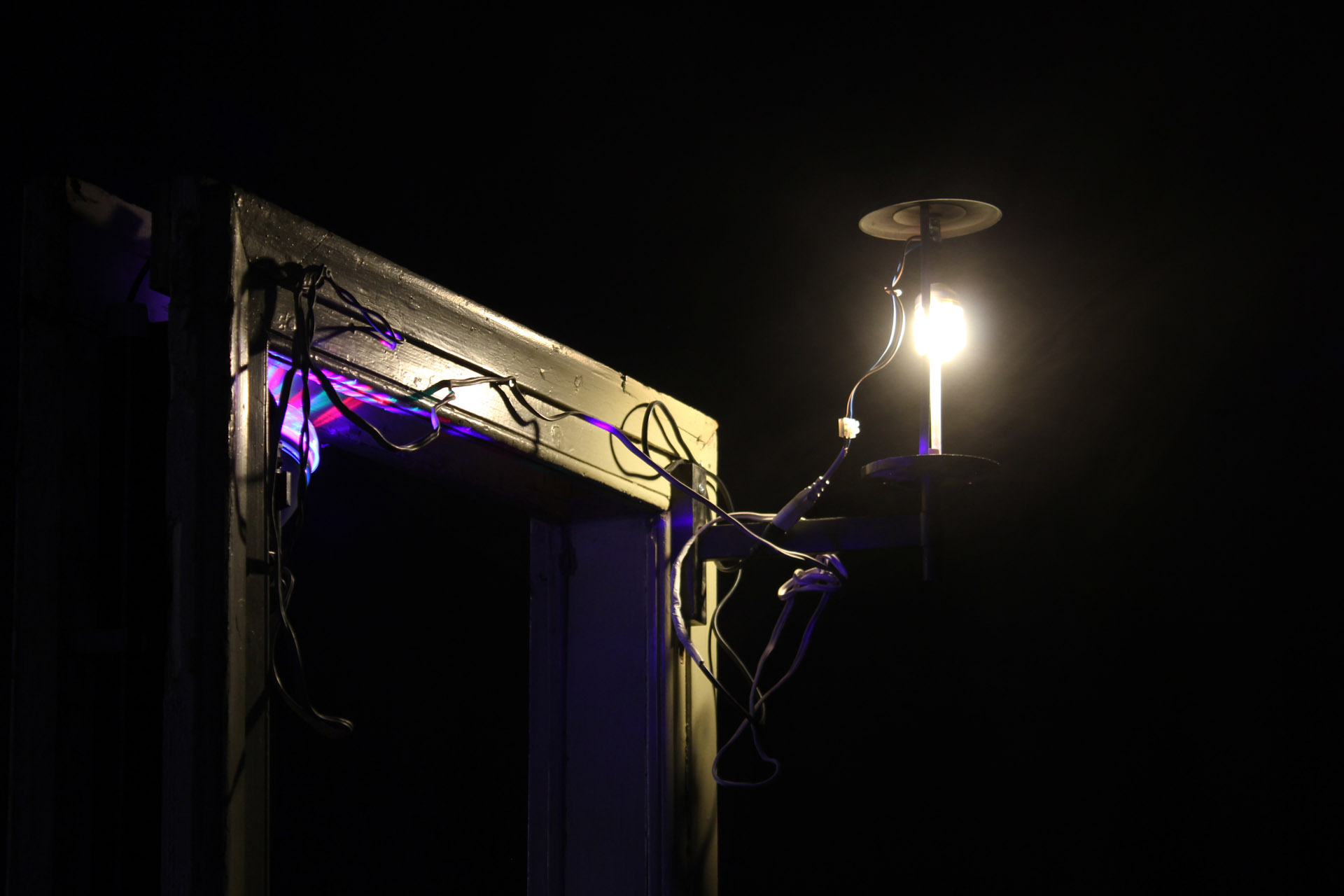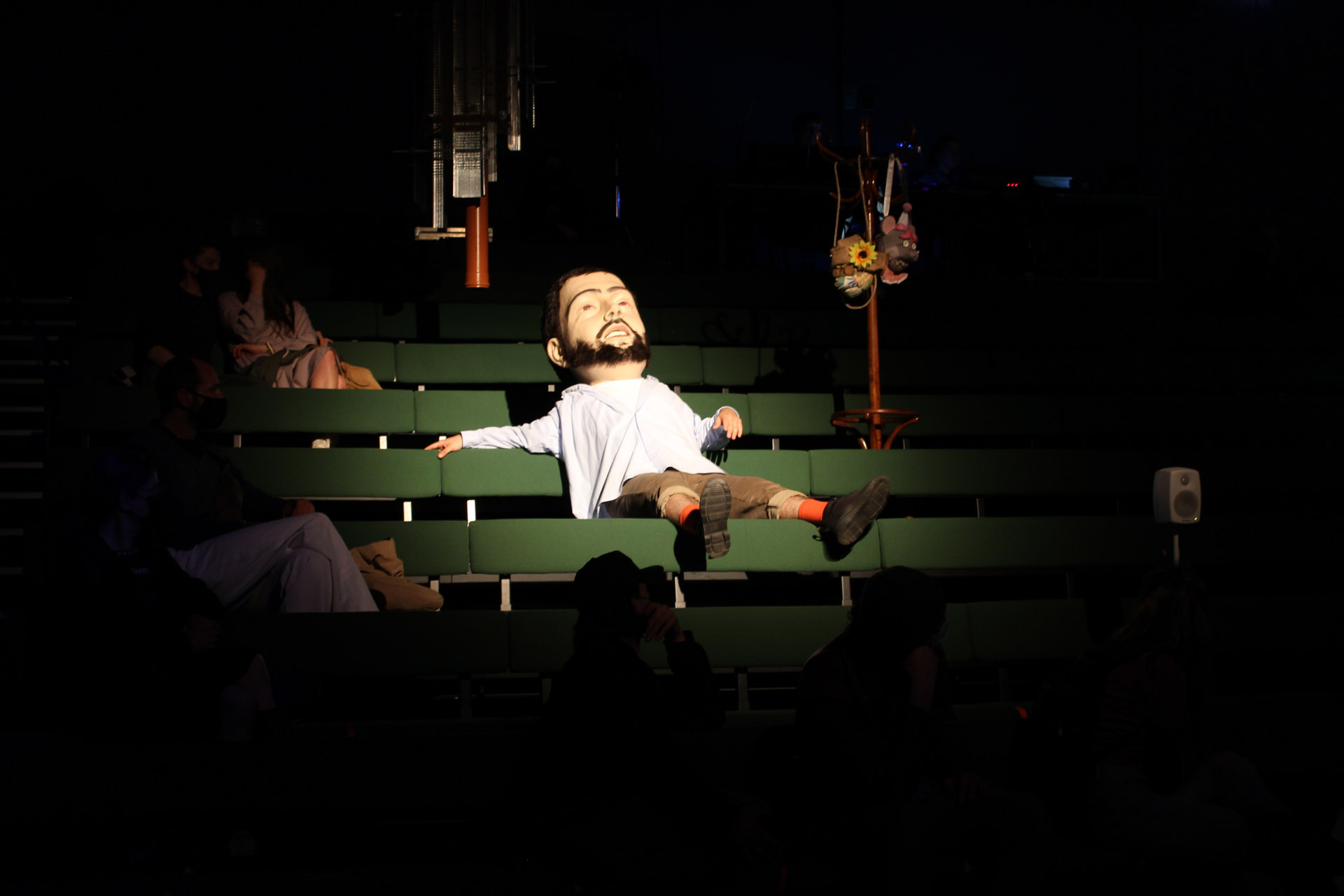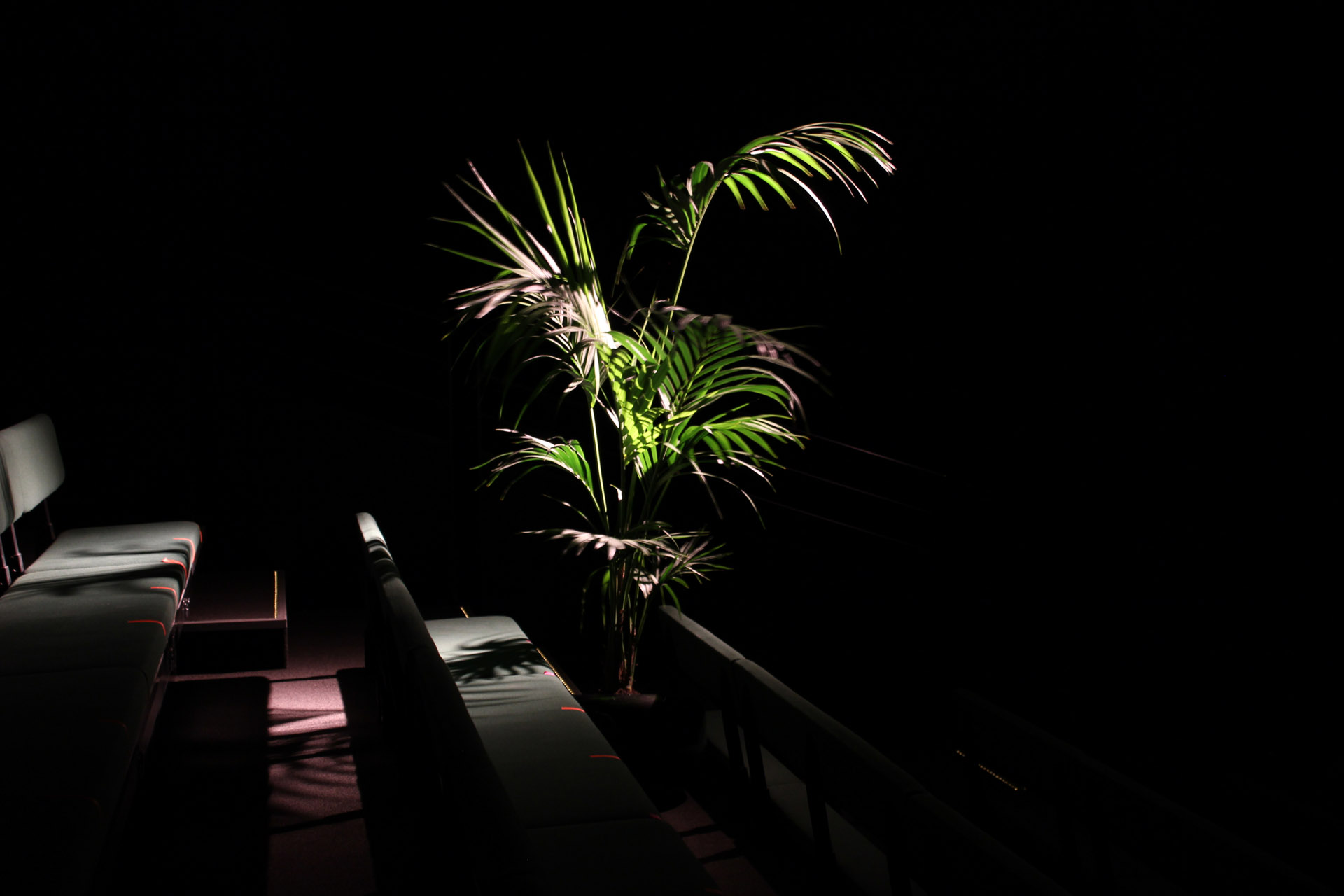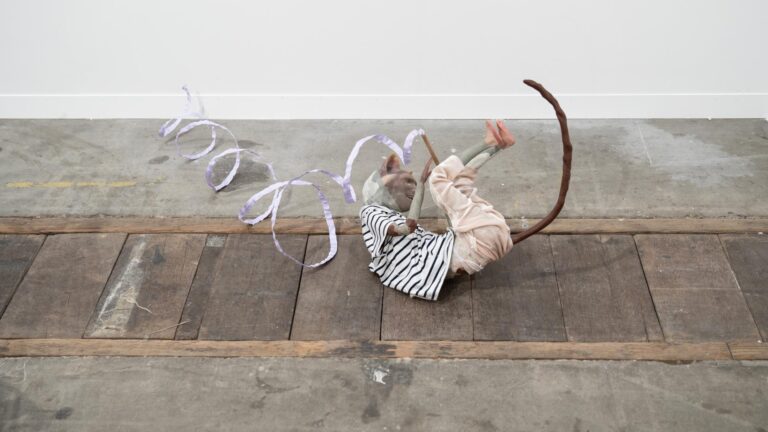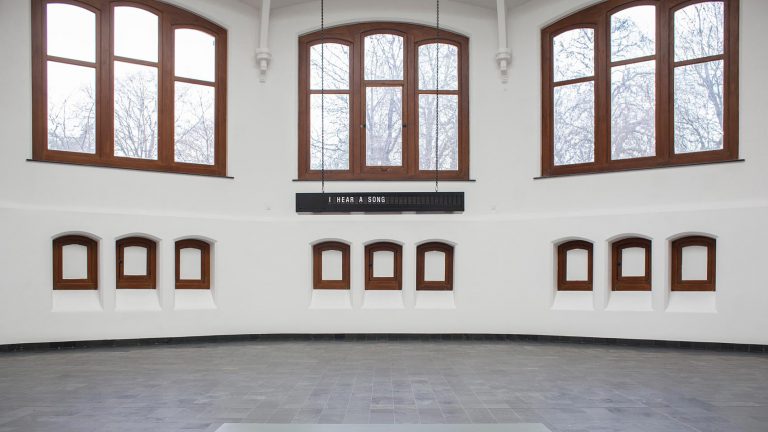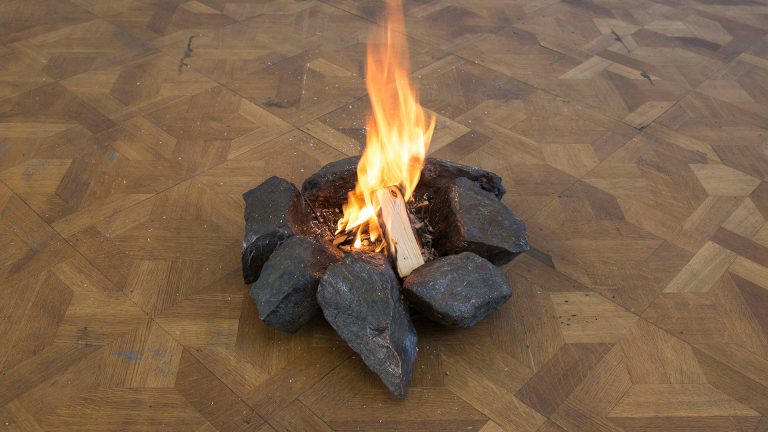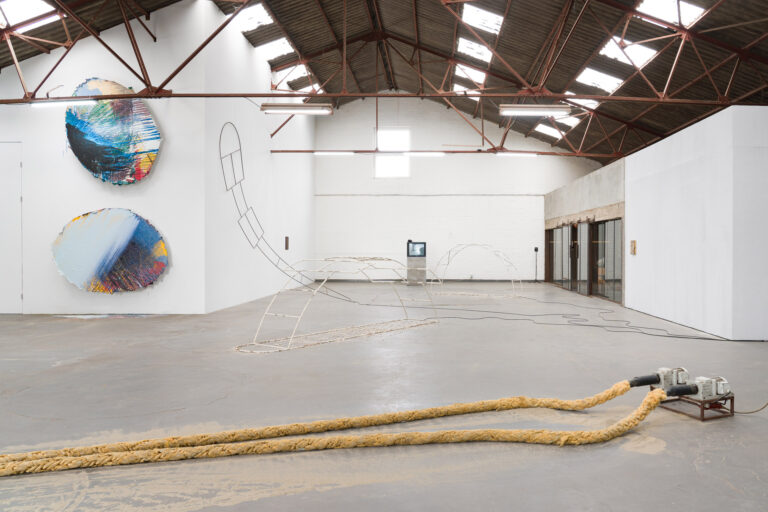Artists: Anouchka Oler-Nussbaum, Stefanie Schwarzwimmer, Pauline Curnier Jardin, Elise van Mourik, Stéphane Barbier Bouvet, Laurie Charles & Nicolas Jorio, Théo Demans & Carolin Gieszner, Arnaud Eubelen, Benoît Gruel, Coraline Guilbeau, Romain Juan, Felix Kindermann, Eva L’Hoest, Stephanie Quirola, Margaux Parillaud & Mie Frederikke Fischer Christensen, Clément Carat, Hugo Dinër
Exhibition title: The Spectacle of our Lives
Curated by: Deborah Bowmann
Venue: De Studio, Antwerp, Belgium
Date: May 16 – 19, 2021
Photography: © Benny Van den Meulengracht-Vrancx and Deborah Bowmann / all images copyright and courtesy of the artists, De Studio, Antwerp and Deborah Bowmann
Every year, De Studio functions as the central location for the Antwerp Art Weekend and Antwerp Art invites a curator to produce an exhibition in one or more of De Studio’s many rooms. This time, Antwerp Art invited artist duo and Brussels based artist run exhibition space Deborah Bowmann, or Amaury Daurel and Victor Delestre, to create a site specific exhibition in De Studio’s biggest space: a giant black box. Titled ‘The Spectacle of Our Lives’, the exhibition is narrated by its artworks, the pieces activating and de-activating, being lit at specific moments in time, while others remain engulfed in darkness, the exposition changing to a slow rhythm. Performers enter the stage, or rather the exhibition space, outspoken and loudly, as well as emerging from a place hidden in plain sight. Art pieces will start to perform and visitors too, who unwarily become part of the whole, blurring the lines between art, artist and the spectator. The exhibition, the spectacle, will not be the same an hour later, so make sure to come back multiple times throughout the duration of the Antwerp Art Weekend in order to experience the entire thing.
‘The Spectacle of Our Lives’ shows pieces by artists Anouchka Oler-Nussbaum, Stefanie Schwarzwimmer, Pauline Curnier Jardin, Elise van Mourik, Stéphane Barbier Bouvet, Laurie Charles & Nicolas Jorio, Théo Demans & Carolin Gieszner, Arnaud Eubelen, Benoît Gruel, Coraline Guilbeau, Romain Juan, Felix Kindermann, Eva L’Hoest, Stephanie Quirola Margaux Parillaud & Mie Frederikke Fischer Christensen, Clément Carat and Hugo Dinër, is curated by Deborah Bowmann and is realized with the support of Antwerp Art, De Studio, Flanders and the City of Antwerp.
About the works:
Anouchka Oler-Nussbaum
‘All Insure, All Unsure’ is a ventriloquist number that originates from different discussions that Lucky and Drama More had over the 2019-2020’s winter. Lucky is a Leo, Scorpio rising with a Capricorn moon when Drama More is a Taurus/Gemini/Cancer. Those conflicting birth charts led Drama and Lucky to have a shifting conversation regarding doubts that cross over other stories, contemplations and digressions on situated knowledge, coping mechanisms, astrology, multiple voices and the remote Gouines Rouges.
Stefanie Schwarzwimmer
‘Silent Revolution’, 2018.
Nighttime. A plate is rotating around its own axis without tipping over. Several people around the world discover the mysterious incident during the night. They film it with their mobile devices and comment on it in their respective languages. The work deals with the increasingly disappearing line between fact and fiction and the disputed notion of the photograph as being evidential as all scenes were built, textured and rendered with 3D Software, although appearing realistic. Silent Revolution plays with these circumstances and explores its speculative potential. It creates an altered string of reality—evidential material for a fictitious event.
Pauline Curnier-Jardin
Explosion Ma Baby, 2016, video installation, HD video, 9 min loop, courtesy the artist and Ellen de Bruijne Projects
It’s August. Feel the suffocating heat of the sun penetrating your skin. All around you, an abundance of flesh is spinning. Thousands of men offer up the naked bodies of baby boys to the angelic icon of San Sebastian. Screams, colours, chants and explosions. Money-garlands. Imagine no women except me. Wait, yes, behind us women are following with devotion, all dressed up in well pressed clothes and their stocking feet. Now, come back here. Imagine how badly I fell in love with this. I desperately want to be part of it. To be there. I wanted to belong. But I know that I can’t. And so I try to capture it on film. I go there and film it every year, over and over, again and again. One day I will tell the story of a poor and sterile man who wants to replace San Sebastian. But more summers will have to pass before our hero will appear.
Directed by Pauline Curnier Jardin Image by Pauline Curnier Jardin and Julien Hogert Music and Sound Design by Vincent Denieul. Editing by Margaux Parillaud. Drums by Benjamin Coli. Co-production by Le Confort Moderne, Poitiers and the Rijksakademie Van Beeldende Kunsten, Amsterdam. Distribution by EYE Film Instituut Netherlands.
The Resurrection Plot, 2015, video installation, HD video, 30 min. loop.
Controversial German anatomist Gunther von Hagens meets philosopher Michel Foucault in Pauline Curnier Jardin’s idiosyncratic rescripting of the Renaissance. In her Resurrection Plot the artist plays with the period’s emphasis on renewal, revival, and regeneration, and invites snails, cicadas, lizards, and snakes – all animals with the ability to don new skins throughout their lives – to join the dance. Among an abundance of references and incongruous juxtapositions, Curnier Jardin conjures a human-sized Bernard Palissy ceramic plate and its overflowing nature; a world of its own. Ignited by the artist’s fascination for the anatomical theaters that appeared in the fifteenth century and the era’s desire to enter and demys- tify the human body, The Resurrection Plot is a voyage amid freed écorchés, contrapposto boogies, and a terrifying Medusa that exposes the audience to fantasies of plastination and petrification. The myth of the “Renaissance Man” and its conquering hubris is undermined in a carnivalesque Gesamtkunstwerk.
Original performance produced by Performa NY, in association with Lafayette Anticipation – Fondation d’entreprise Galeries Lafayette, Paris. Supported by the Rijksakademie van Beeldende Kunsten, Amsterdam, Institut Français à Paris, and the Cultural Services of the French Embassy in the U.S and Fonds de dotation Famille Moulin. World premiere presented in New York at Pioneer Works as part of Performa 15, Nov 2015. Curated by Charles Aubin.
Stéphanie Quirola
Stephanie Quirola’s video ‘THE FUTURE WAS DARK’ will be screened twice a day. It revolves around a recorded performance, and more particularly around a performative object, a mouthpiece designed by Stephanie Quirola and produced by Juanita Care, a renowned jeweler.
This video stems from continuous questions about the future and imagines ways to shift from a linear perception of time. What happens when you place the past in front and not behind? What is the future in the context of the present and how is it impacted by the actions we take today? When does post-colonial cultural exploitation end and when does mutual enrichment of cultures begin? What is real and what is fake? What is the present, past, and future?
Margaux Parillaud and Mie Frederikke Fischer Christensen
Under siege, film, 6min, 2018.
‘Under Siege’ is one in a series of performative films which addresses the current political landscape by looking at the transition from feudalism to capitalism and researching its influence on structural violence in regards to both gender and race. Questioning ideas of reenactment, historic accuracy and the complications of celebrating, glamorizing or erasing past narratives. The esoteric costumes remix our ideas of old and contemporary clothing and place the ritualized, laborious, and collaborative act of firing the trebuchet in another time, where reenactment is history itself. This activation of a trebuchet against the invisible attempts to queer our collective appropriations of past narratives and sail past ideas of the “old world” the “new world” towards an “other world”.
Prologue, film, 2 min loop, 2014.
Through an investigation into the power relationship between women in film and popular culture and the clichés surrounding female confrontation, this reenactment of a soap opera scene is cut down to a looped and speechless dialogue between two women. Their faces are carved into archetypes, as they both excessively express their woman to woman drama without revealing any motive behind their wordless confrontation. The passive pastels reflect their simmering passive aggression and anticipates the outburst ́s of violence to come… The title of this video relates to the following work ‘Well Now it Looks as if You are Armed for Battle’ and situates the movie as the prologue of the entire collaborative practice of the duo.
Clément Carat
“What I like about the Cabezudo sculptures, which have been used in Spanish carnivals for centuries, is that they are able to come alive. They always remind me of the story of Dedalus who was sculpting nature so perfectly that people decided to chain his sculptures during the night in the fear that they would get up and run away. You can touch the Cabezudo, you can interact with them, fight with them, play with them. However, I did not want to caricature someone else. The Cabezudo are often made to mock someone. So I decided to ask a Cabezudo craftsman to make my own face. In order to modernise it I have cast it with mimetic materials, such as silicone commonly used in cinema for special effects. The result is a sculpture that looks strangely alive. A bit lonely or maybe a bit surprised with its wide open mouth. This sculpture is just trying to manage its own life as it can, like a Golem (a protective living giant made of clay in the jewish culture) who would have lost his master.”
Direction: Clément Carat, Master Cabezudo: Ramon Aumedes, Production mold, traditional cabezudo: Taller Saradanca, Aumedes family. Production: Silicone and mimetic materials: Studio Abajo, Pedro Rodriguez Abajo
Clothes: Aurélien Lepetit. Project produced in the frame of a residency at the Casa de Velazquez, French Academy in Madrid.
Hugo Dinër
A choir of seven mice accompanies a dog and a cat singing popular songs. All together they rehearse their past lives.I tried so hard, And got so far
Appeared in nineteen ninety-two. Planted in autumn, blossoms in spring. Likes good things in bad taste. Requires little maintenance. Let’s salute the effort!
Elise van Mourik
In the background of an airport lounge, a business lobby, a shopping center, the flexible office, or other open plan architectures. Rotating Plants reflects on the ‘always-on’ corporate culture associated with open plans, and on the confusion of biological time with that of economy.
The pots were previously exhibited in the Catherine Vertige Collection, Brussels, at Bozar at the occasion of ‘Somewhere in Between’, as well as during ‘Sun Set Cinema’ at Marion De Canniere, Antwerpen.
Stéphane Barbier-Bouvet
WEEK-END, 2015, Galvanized steel, meranti wood, 130 x 130 x 74 cm
Week-End is a type of furniture found in anonymous public spaces such as parking lots or service stations. This piece was inspired by a table spotted at a metal construction factory which was assembled by the workers themselves with their own tools, outside of the assembly line. It’s a form of self-initiated ownership, a re-appropriation of working conditions, commandeering them to one’s own benefit. Even if weekends are the moment associated with freedom and travel, all possible escape simultaneously dissolves because of an already formatted situation – you won’t get to see anything new.
HEALING, 2015, found door frames and found lamps, bricks, Variable dimensions
Healing was first developed as the lighting system using found lights for the exhibition ‘Amygdala’ in 2015 with Vanessa Safavi at The Breeder in Athens. The latter is located in an area where the lamps at the entrances of sex clubs became a significant light source as the city struggled to provide maintenance and repair of the district’s streetlights. The work notes how light and its diffusion in public space evolved during the crisis according to types of available employment.
Laurie Charles and Nicolas Jorio
Laurie Charles’ film Le Chalet unfolds itself as a strongly layered story, wherein four friends retreat into “the unspoiled nature”, reflecting upon alternative ways of (communal) living outside the social reality of busy city-life. Through the re-enactment of mystical rituals and theatrical experiments in nature, Le Chalet excites a – though fictitious – utopian community. Charles consciously uses cliché imagery of our contemporary experience of nature, which underlines the fictitious dichotomy between nature and culture. In her film, genres such as documentary, fiction and horror blend almost imperceptibly into one another and the shack becomes a character that slowly comes to life. All the more, the camera transforms into an omniscient eye considering humans, animals and objects as equals. – Dagmar Dirkx.
“Frequently, I consider myself a guitarist (playing with a group and solo) and introduce myself as such. Still, my practice as a sound artist spreads wider – from soundscapes built specifically for a theater environment, to field-recordings and the recording of sound for films. I also program and host radio shows, and lathe-cut my own vinyl records. All these different practices come together in my relationship to sound, this object that exists but that I do not see, and which gives focus to my research on the relationship between the material and the immaterial.” Nicolas Jorio
Touche~touche (Théo Demans and Carolin Gieszner)
Touche~touche duo was formed in 2018, from the encounter of Carolin Gieszner and Théo Demans. Together, they developed a creation process by placing their work in the scenographic realm as well as the relational craftsmanship and that of the immersive installation.
Moving from the museum to the theatre world, designing night clubs or a recording studio as well as immersive cinema rooms and gallery exhibition, they are implementing their practice through a collaborative journey.
The evasive practice of touche-touche, transports the viewer to an empire of dreamlike experience and tactile illusions.
Melting tiles, soft rocks, absurd gravity and abstract sciences are some of the matters they employ: simulated textures and artificiality give the viewer a highlighted awareness of touch and redirect objects into a mental image. Senses are played with and pragmatic interaction slowly resides to a secondary position.
Each imagined scene is a reinterpretation of existing cultural traditions and techniques. Manufactured in intricate detail, using contemporary materials and processes, they create new fiction for daily scenarios. Their environments are a free fall in tangible reality, emphasizing on the sensual relation we form with our surrounding.
Arnaud Eubelen
No Man’s Land (2020)
It is a sculpture with an industrial look that stands before us. By entering the exhibition room, the light generated by this lighthouse is unleashed and takes all its magnitude, to the point that the glare makes a prolonged face-to-face face-to-face almost impossible. The form also reveals itself in its entirety: pipes, corrugated PVC and industrial LEDs contrast with with a tree trunk planted in a raw concrete base. No noble materials noble materials, no manioc forms; an assembly in a raw state which which releases, in addition to a blinding light, a low and buzzing sound taken directly in the entrails of the medusant “beast”. With this work, the artist, in a provocative approach, gives to see an installation difficult to look at. “We find this type of lighting very strong and intense on the freeway areas or in the prisons. They are lights which are made so that all people present on the site see and be seen. It is a generally used to operate a surveillance or ensure the security. security. There is undeniably an authoritarian character in this object which formally could refer to the Panopticon. This device chase the zones of shade while camouflaging itself with the materiality of the urban context.” – Kevin Mulhen
Meat Point (2020)
Place of meeting and pleasure, this bench is directly inspired by the aesthetic codes and aesthetic and material codes found in butchery. This object functions as This object functions as a display counter highlighting all those who come to sit on it.
Shared Night Activity (2019)
“This image often comes to mind: consider the walls of a house like a skin, what happens if you remove this skin, if it is turned over, if it is turned inside out, if it is torn. The house becomes a set of layers to be peeled off, the heart of the building is revealed. The wall becomes porous, it changes scale, metamorphoses into an object to integrate the space it delimits”. When the sun takes its leave, artificial light takes over. The street lamps wake up, we turn on the chandeliers on the ceiling and the neon lights in the office. It is the testimony of an activity which becomes visible, which becomes perceptible. The interior rubs shoulders with the exterior without ever mixing with it. The light and everything is reversed. Each one at home develops his own comfort which, from the street, could look like a collective work of façade composition.
Utility Shaft (2020)
PVC tube, grid, threaded rod, led tube, wired glass, wood, chain.
Basement to Rooftop (2020)
At different scales, these two objects question the verticality of our city dwellings. Sort of architectural portraits, they are views of the building highlighting its ways of displacement ascending. Most of the time we go up to reach the comfort of the home and we go down to make bodies with the urban reality. These physical actions take place in places often closed bringing from a door to another door to another, from one state to another. I wanted to consider these transition places as she, as one would for an object, to linger on their materiality and their materiality and their force of conditioning, to develop a narration of it.
Benoît Gruel
“What creates the “spectacular”? the Apparat, the frame, the 4th wall, the ticket, the spectator, the show itself?
“What does a clown do when he is not “working”? Is “the show must go on”? Can we really stop the show?
It doesn’t concern me anymore, I’ve given up my nose,
I’m nothing that you would be interested in.”
Coraline Guilbeau
“If we believe what is being said
all the images run away
what remains at the end is the sad wind
that whistles on frozen hands
our head hidden between the frozen hands
But this night,
I have like a sun in my eyes
of what suddenly could be
-the spring-
Extract from Lovely Season, 2021, Coraline Guilbeau
Romain Juan
‘A matter of life and death’, 2021.
It’s something smoking, a bit like me.
Felix Kindermann
In his sound work ‘Very Emotional Piece’, developed for this exhibition, Felix Kindermann returns to his method of spatio-temporal separation of performers who do not encounter each other while following the same instructions for action. In this case, the trained voices of two actors interpret all human emotions and enter into performative competition with each other. Their sound, on the other hand, builds up an increasingly complementary tension between synchronicity and asynchronicity. Through the simultaneous playback of the time-shifted recordings, opposition and sameness are combined into an indissoluble unity.
Actors: Tess Bryant, Davis Freeman.
Eva L’hoest
Eva L’Hoest’s video ‘Pareidolia’ (2016 – 10mn HD video) took place in the Mediterranean Sea near the “Domus de Janas”, at several palaeolithic sites around a desert island of pink granite lava reefs. These anthropomorphic rocks were once used as landmarks by sailors lost at sea and supposedly inspired the construction of the funeral chambers the “Giants’ Tombs”, dating back to 3000 BC. This film was shot on a winter night and presents the constant rolling over onto itself of this mineral. The filmic mechanism substitutes for the human eye and gets lost in the island’s rocky lines.
The Spectacle of Our Lives was realized with the support of Antwerp Art, De Studio, Stad Antwerpen and the Flemish Government.



